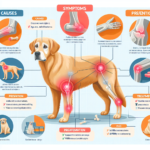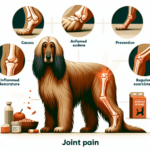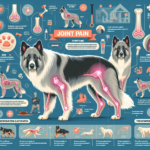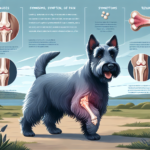Goldador Joint Pain: Causes, Symptoms, Prevention, and Treatment

Introduction
The Goldador, a hybrid breed resulting from the cross between a Golden Retriever and a Labrador Retriever, is known for its friendly demeanor, intelligence, and versatility. This breed has gained popularity due to its excellent temperament, making it a great family pet, service dog, and working dog. Goldadors inherit the best traits from both parent breeds, including their affectionate nature and high energy levels.
However, like many large breeds, Goldadors are prone to certain health issues, with joint pain being a significant concern. Joint health is crucial for maintaining the quality of life in Goldadors, as it directly impacts their mobility and overall well-being. Understanding the causes, symptoms, prevention, and treatment of joint pain in Goldadors is essential for owners to ensure their pets lead healthy and active lives.
Breed-Specific Joint Pain Risks
Genetic Predisposition
Goldadors are genetically predisposed to several joint-related issues, primarily due to their parent breeds. Both Golden Retrievers and Labrador Retrievers are known to suffer from conditions such as hip dysplasia, elbow dysplasia, and arthritis. Hip dysplasia is a hereditary condition where the hip joint does not fit properly into the hip socket, leading to pain and mobility issues. Elbow dysplasia involves abnormal development of the elbow joint, causing lameness and discomfort. Arthritis, a degenerative joint disease, is also common in Goldadors, especially as they age.
Age-Related Risks
As Goldadors age, the risk of developing joint pain increases. Typically, signs of joint issues may start to appear in middle age, around 5 to 7 years old. However, some Goldadors may show symptoms earlier, especially if they have a genetic predisposition. Senior Goldadors, those over 8 years old, are particularly vulnerable to arthritis and other degenerative joint conditions.
Activity Level and Joint Stress
Goldadors are active and energetic dogs that require regular exercise to stay healthy. However, their high activity levels can also contribute to joint stress, especially if they engage in high-impact activities like jumping, running on hard surfaces, or participating in strenuous sports. Working Goldadors, such as those used in search and rescue or as service dogs, may also experience increased joint wear and tear due to their demanding roles.
Common Symptoms of Joint Pain in Goldadors
General Symptoms
- Limping: One of the most noticeable signs of joint pain is limping or favoring one leg over the other.
- Stiffness: Stiffness, especially after rest or sleep, can indicate joint discomfort.
- Reluctance to Move: A Goldador with joint pain may be hesitant to engage in activities they once enjoyed, such as running, jumping, or climbing stairs.
- Swelling: Swelling around the joints can be a sign of inflammation and pain.
- Behavioral Changes: Irritability, lethargy, or changes in behavior can also indicate joint pain.
Breed-Specific Symptoms
In Goldadors, symptoms of joint pain may be more pronounced due to their size and activity level. Owners may notice their Goldador struggling to get up from a lying position, showing signs of discomfort when touched around the joints, or having difficulty maintaining their usual pace during walks.
When to Consult a Vet
If a Goldador exhibits any of the above symptoms, it is crucial to consult a veterinarian promptly. Early diagnosis and intervention can significantly improve the dog’s quality of life and prevent further joint damage. Regular veterinary check-ups are also essential for monitoring joint health and catching any issues early.
Preventive Measures for Joint Health
Exercise Recommendations
Maintaining an appropriate exercise routine is vital for Goldadors to keep their joints healthy. Low-impact activities such as swimming, walking on soft surfaces, and controlled play sessions are ideal. Avoiding high-impact exercises like jumping or running on hard surfaces can help reduce joint stress. Consistent, moderate exercise helps maintain muscle strength and joint flexibility.
Dietary Suggestions
A balanced diet rich in essential nutrients supports joint health in Goldadors. Foods containing glucosamine and chondroitin can help maintain cartilage health. Omega-3 fatty acids, found in fish oil, have anti-inflammatory properties that can benefit joint health. Consulting with a veterinarian for dietary recommendations and appropriate supplements is advisable.
Weight Management
Maintaining a healthy weight is crucial for reducing joint stress in Goldadors. Excess weight puts additional pressure on the joints, exacerbating pain and discomfort. Owners should monitor their Goldador’s weight and adjust their diet and exercise routine as needed to prevent obesity.
Early Screening and Monitoring
Regular veterinary check-ups and early screening for joint issues can help catch problems before they become severe. For Goldadors, screening tests such as X-rays or joint fluid analysis can be beneficial. Monitoring the dog’s movement and behavior for any signs of discomfort can also aid in early detection.
Treatment Options for Joint Pain
Non-Surgical Treatments
Non-surgical treatments for joint pain in Goldadors include:
- Medications: Anti-inflammatory drugs, pain relievers, and joint supplements can help manage pain and inflammation.
- Physical Therapy: Physical therapy exercises can improve joint mobility and strengthen muscles around the joints.
- Lifestyle Adjustments: Modifying the dog’s activity level and providing a comfortable living environment can alleviate joint stress.
Surgical Options
In severe cases, surgical intervention may be necessary. Common surgical options for Goldadors with joint pain include:
- Hip Replacement: Total hip replacement can provide significant relief for dogs with severe hip dysplasia.
- Arthroscopy: Minimally invasive surgery to remove damaged tissue or repair joint structures.
- Joint Fusion: Fusing the joint to eliminate pain caused by movement in severely damaged joints.
Alternative Therapies
Alternative therapies can complement traditional treatments and provide additional relief for Goldadors with joint pain. These include:
- Acupuncture: Acupuncture can help reduce pain and inflammation by stimulating specific points on the body.
- Hydrotherapy: Water-based exercises can improve joint mobility and reduce pain without putting stress on the joints.
- Massage: Therapeutic massage can help relax muscles, improve circulation, and alleviate joint pain.
Lifestyle and Management Tips
Daily Care Routine
A daily care routine for a Goldador with joint pain might include:
- Gentle, low-impact exercise such as short walks or swimming.
- Administering prescribed medications and supplements.
- Providing a balanced diet with joint-supporting nutrients.
- Regular physical therapy sessions or home exercises recommended by a veterinarian.
Modifying the Home Environment
Making the home environment more comfortable for a Goldador with joint pain can significantly improve their quality of life. Consider the following modifications:
- Using ramps or steps to help the dog access furniture or vehicles.
- Providing orthopedic beds to support joints during rest.
- Ensuring food and water bowls are at a comfortable height to reduce strain on the neck and joints.
Long-Term Management
Long-term management of joint pain in Goldadors involves ongoing care and monitoring. Regular veterinary check-ups, maintaining a healthy weight, and adjusting the exercise routine as needed are essential. Owners should also stay informed about new treatments and therapies that may benefit their dog.
FAQs About Goldadors and Joint Pain
What are the early signs of joint pain in Goldadors?
Early signs of joint pain in Goldadors include limping, stiffness, reluctance to move, and behavioral changes such as irritability or lethargy.
Can joint pain in Goldadors be prevented?
While genetic predisposition cannot be entirely prevented, maintaining a healthy weight, providing appropriate exercise, and regular veterinary check-ups can help reduce the risk and severity of joint pain.
Are there specific diets that can help with joint health in Goldadors?
Yes, diets rich in glucosamine, chondroitin, and omega-3 fatty acids can support joint health. Consult with a veterinarian for specific dietary recommendations and supplements.
When should I consider surgery for my Goldador’s joint pain?
Surgery should be considered when non-surgical treatments are no longer effective, and the dog’s quality of life is significantly impacted. A veterinarian can provide guidance on the best surgical options based on the dog’s condition.
What alternative therapies are effective for managing joint pain in Goldadors?
Alternative therapies such as acupuncture, hydrotherapy, and massage can complement traditional treatments and provide additional relief for joint pain in Goldadors.
Conclusion
Joint pain is a common concern for Goldadors, but with proper care and management, owners can help their pets lead comfortable and active lives. Understanding the causes, symptoms, prevention, and treatment options for joint pain is essential for maintaining the health and well-being of this beloved breed. Regular veterinary check-ups, a balanced diet, appropriate exercise, and early intervention are key to ensuring the long-term joint health of Goldadors. By taking proactive measures, owners can provide their Goldadors with the best possible quality of life.




